Home
Enabling a Greener Economy and Sustainable Living
Enabling a Greener Economy and Sustainable Living
Enabling a Greener Economy and Sustainable Living
How we live and work in the National Park needs to change to respond and adapt to the nature and climate crises. We also need to consider how development, and investment in infrastructure can support this.
As Scotland moves towards becoming a Net Zero Nation our economy must adapt to support this, as well as the further investment required in nature and land. We need to understand more about the opportunities this can bring for the local economy and how the benefits from this can be shared in a fair and just way, for existing businesses, people and local communities.
Housing and transport are two of the biggest issues causing barriers to more working age and young people being able to find a home and jobs in the National Park. These issues also need to be addressed to support the transition to a greener economy and to encourage more local living.
Living and working more locally will reduce our reliance on carbon by making residents less dependent on driving to other areas, as well as supporting more vibrant, healthy communities. We also need to support communities to adapt to the changing climate and how this directly impacts their infrastructure, like roads, and environment. Building on existing examples of communities taking action to develop their resilience and using Local Place Plans can help this transition.
Being a National Park doesn’t mean there can be no development here, but the Scottish Government has made it clear that to respond to the climate emergency and nature crisis, all investment and development must contribute to making Scotland a more sustainable place. Development and infrastructure investment within the National Park has an increasingly important role in addressing the climate emergency, restoring nature and supporting rural communities.
Enabling a Greener Economy and Sustainable Living will need a focus across three main areas:
- Transitioning to a Greener Rural Economy
- Living Well Locally
- Harnessing Development and Infrastructure Investment
A series of objectives and actions have also been proposed to help meet our aims in each of these areas.
You can read more about each of these areas in our Draft National Park Partnership Plan 2024-29 or click 'Next' below to learn more about how we can enable sustainable living and working in the National Park.
Transitioning to a Greener Rural Economy
What do we mean by Transitioning to a Greener Rural Economy?
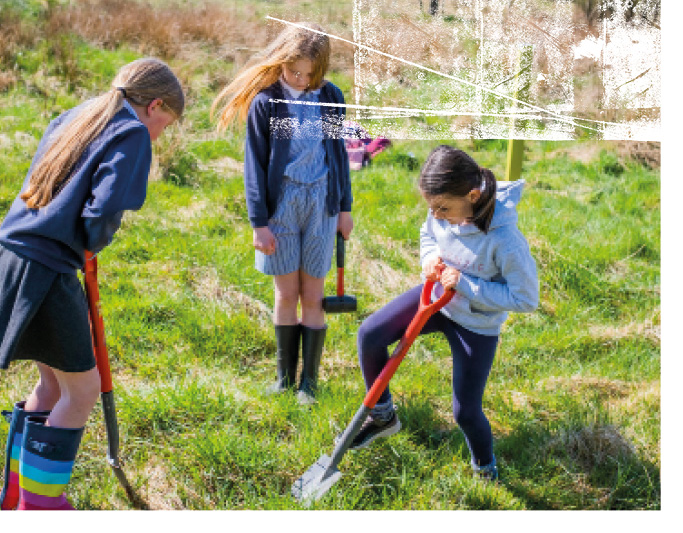 Addressing the climate emergency and nature crisis requires the National Park’s rural economy to transition towards becoming greener and more diverse than it is now. This means supporting a rapid transition of our business sector towards becoming net zero, as well as securing increased investment in our land-based sector, to help mitigate and adapt against the impacts of climate change and help restore nature.
Addressing the climate emergency and nature crisis requires the National Park’s rural economy to transition towards becoming greener and more diverse than it is now. This means supporting a rapid transition of our business sector towards becoming net zero, as well as securing increased investment in our land-based sector, to help mitigate and adapt against the impacts of climate change and help restore nature.
To facilitate this, significant growth in local ‘green jobs’ is expected to be required. These types of jobs are yet to be precisely defined or quantified for the National Park, however these will be needed across multiple sectors and particularly in the nature-based land sectors. Additional specialist skills and expertise are likely to be required to support businesses to get to net zero, alongside the need for new jobs and skills across various sectors and technologies such as digital, transport, tourism, renewable energy and construction.
What is the current situation?
Right now, businesses in the National Park are experiencing some of the most difficult operating circumstances in a generation, brought about by adjusting to Brexit, COVID-19 and the current cost of living crisis. The National Park Destination Group, made up of local tourism business representatives from across the National Park, say that escalating operating costs, skills shortages and recruitment challenges are being experienced across all sectors, with the tourism and hospitality sectors having to make changes to how they operate, either reducing or scaling back on their business hours or the services they provide at a time when visitors are returning to the National Park.
Lack of availability of local housing for staff and good public transport links are compounding factors affecting the ability of businesses to attract and retain staff. However, current levels of business rates and VAT levels are stated by many businesses to be the key issue impacting on both short and long-term planning, alongside responding to legislative changes including the consideration of a Local Visitor Levy and Short Term Let Control areas.
Many businesses are taking steps to reduce their carbon footprint by making changes to their energy usage and waste systems and supporting local supply chains. Business collaboration and projects within the visitor sector are also supporting people to make greener choices and change behaviour. This sector has a significant role as ambassadors for the National Park through their interaction with visitors and opportunity to connect with a broad range of people.
This economic transition is also happening at a time when the National Park is experiencing an aging population and loss of working age and young people. The most recent projections indicate a decline in population overall from around 14,700 (2018 estimate) to 14,300 by 2028. However, small area population forecasts suggest this will differ between communities with some experiencing an increase in population. Engagement with young people through the National Park Youth Committee suggests that they may find it hard to know what skills are going to be needed and, aside from hospitality sector, what job opportunities are likely to be available to them within the National Park.
What could it be?
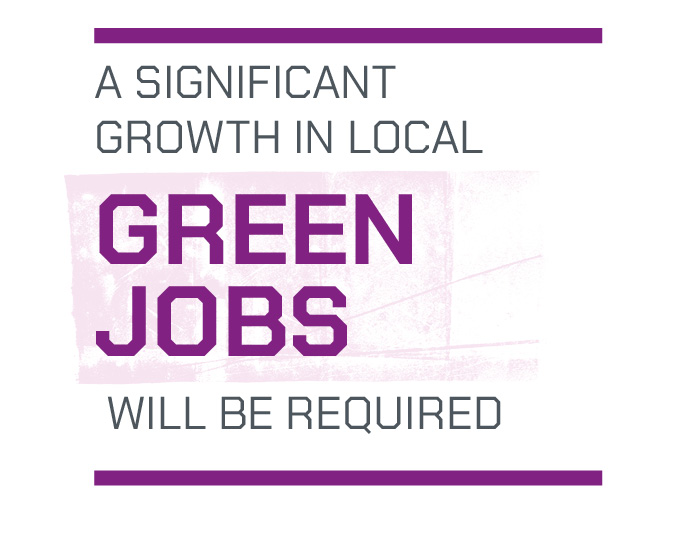 Investment in natural capital as part of our transition to net zero could provide significant new employment opportunities. This has been found in studies from other rural areas of Scotland with similar landscapes, such as recent research undertaken by Highlands and Islands Enterprise to investigate opportunities arising from investing in natural capital in Argyll and Bute. Analysis by NatureScot expects that nationally there will need to be extensive growth in nature-based jobs such as woodland planting and peatland restoration.
Investment in natural capital as part of our transition to net zero could provide significant new employment opportunities. This has been found in studies from other rural areas of Scotland with similar landscapes, such as recent research undertaken by Highlands and Islands Enterprise to investigate opportunities arising from investing in natural capital in Argyll and Bute. Analysis by NatureScot expects that nationally there will need to be extensive growth in nature-based jobs such as woodland planting and peatland restoration.
The increase in flexible ways of working post-COVID, such as home or hybrid working and options to work from local business hubs, supports more local and lower-carbon living and working. There are already business hubs in Aberfoyle and Drymen and some trials underway using local village halls as multipurpose venues, breathing new life into rural facilities and helping to sustain these.
Community and third sector enterprises have the potential to grow as part of our transition to a wellbeing economy. There are many examples of innovative community-led enterprises across the National Park including community-run village halls, a café, pontoons, visitor centre, business hub and a post office/newsagent and pub. All of these generate income that supports greener, local living. Some communities also have their own run of river hydro schemes that provide a clean source of energy and income to the local community as well.
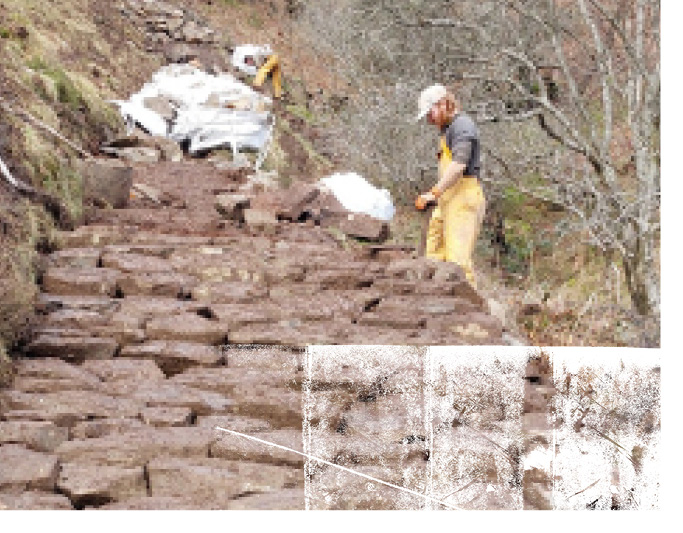 Ensuring communities are supported to maintain and build capacity in their local organisations, through supporting more local people, including young people, to get involved could result in more social enterprises like these being established and supporting local wealth building.
Ensuring communities are supported to maintain and build capacity in their local organisations, through supporting more local people, including young people, to get involved could result in more social enterprises like these being established and supporting local wealth building.
Our aim by 2045
The National Park has a greener and more diverse rural economy, with businesses capitalising on the market advantage of restored nature and a net zero place; supporting an increase in working age population and contributing towards, sustainable, thriving communities.
Use our interactive map to tell us where in the National Park you think there are opportunities to facilitate better local living and working.
Living Well Locally
What do we mean by Living Well Locally?
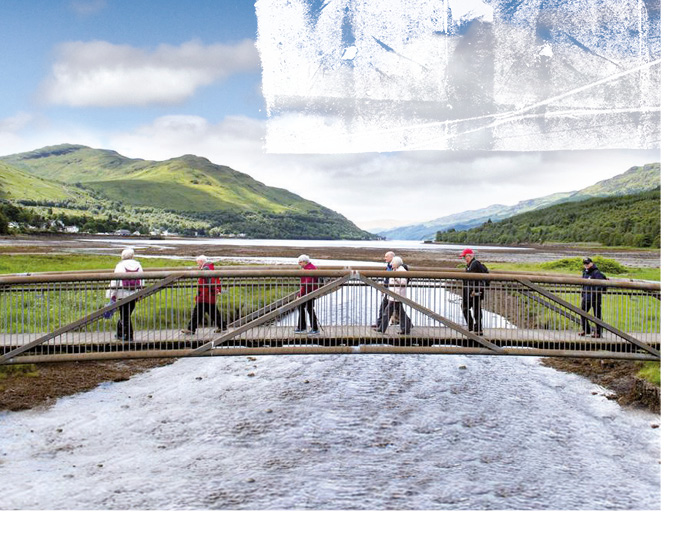 One of the ways we can all change behaviours to reach net zero is by acting quickly to reduce our reliance on carbon, and by living more locally. This is about ensuring that people are increasingly able to meet their daily needs as close as possible to where they live or work without needing to use a car, and instead by using active travel (walking, wheeling or cycling) or public transport.
One of the ways we can all change behaviours to reach net zero is by acting quickly to reduce our reliance on carbon, and by living more locally. This is about ensuring that people are increasingly able to meet their daily needs as close as possible to where they live or work without needing to use a car, and instead by using active travel (walking, wheeling or cycling) or public transport.
Living well locally can also:
- Support improved quality of life, health and wellbeing for many people by supporting more active lifestyles
- Strengthen and deepen the connections between people and the places where they live – with nature, culture and local heritage
- Support vibrancy in the local economy, rural businesses, third sector enterprises and increase opportunities for generation and retention of local wealth
To support people in our communities to live well locally we must also support communities to adapt and build resilience towards the changing climate and its direct impacts on people, villages, rural infrastructure and the local environment.
What is the current situation?
In a rural area like the National Park, travelling by car is very often a necessity rather than an option. Our communities rely on each other and the towns and villages around the National Park for shops, health care, education, employment and a range of other services and facilities. Travel between, and in many cases within communities, can be challenging without a car, especially for young people. Communities would like to see improvements to the frequency, timing and connectivity of public transport services and the places they can travel to. More active travel options will also help support sustainable travel and improve wellbeing. These options include, where possible, off-road connections between communities that are currently linked by trunk roads with large volumes of traffic travelling at speed.
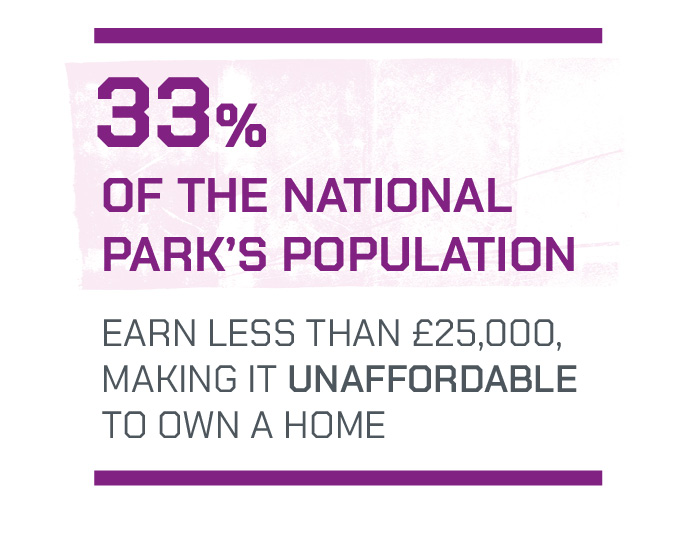
Access to affordable housing continues to be a significant issue, including provision of a different range of housing types and tenures. This is despite an increase in affordable housing in the National Park in recent years. Commuting, retirement and an increased desire for rural living post pandemic are thought to be key factors driving up housing pressures, alongside increasing numbers of second homes and short-term holiday lets in many communities. Whilst these can benefit the visitor economy, some communities are concerned that we’re reaching a tipping point where too many homes are being used as holiday lets and second homes, having a detrimental impact on communities and local businesses.
Privately owned housing is dominant in the National Park, which means it is extremely challenging for low to moderate income households to own a home. This combined with a limited supply of both social and private rented sector housing compounds the difficulties people face when looking for somewhere to live in the National Park.
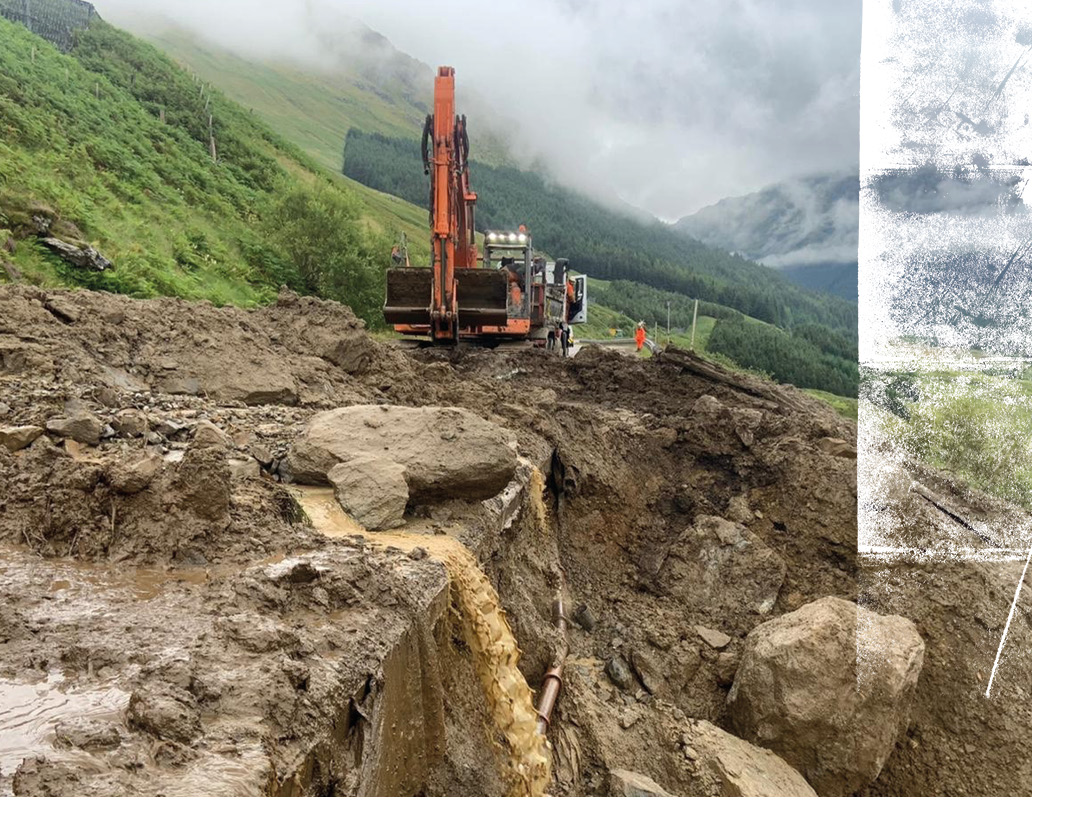
Flooding and landslips are perhaps the most obvious and direct impacts of the climate emergency on our communities and businesses. However, climate change impacts all aspects of life, health and the economy. Communities need to build resilience to the increasing impacts of the changing climate, including increased heavy rainfall events, hotter, drier summers (which increases instances of water scarcity and wildfires) and sea level rise. Communities can also help manage the impacts climate change is having on nature – in our forests, woodlands, lochs and rivers, as well as influence the behaviours, systems and land use changes now needed to help us all adapt to living with climate change.
While many communities are proactively leading local action to address these issues, community-led action relies on local people with confidence and skills volunteering their time and expertise, and not all communities currently have the same level of ability to identify and take local action. Right now, support for communities on climate action is shared across multiple partners and organisations.
What could it be?
Communities are already delivering to support local living. Examples include community-led action on local energy generation via community owned run of river hydro schemes; local food growing and distribution; scoping of local community-run transport enterprises; community-based health walks/cycling groups and community run business hubs. We could build on these examples to encourage and empower all communities in the National Park to take action towards living well locally, adapting to the Climate Emergency and delivering for nature.
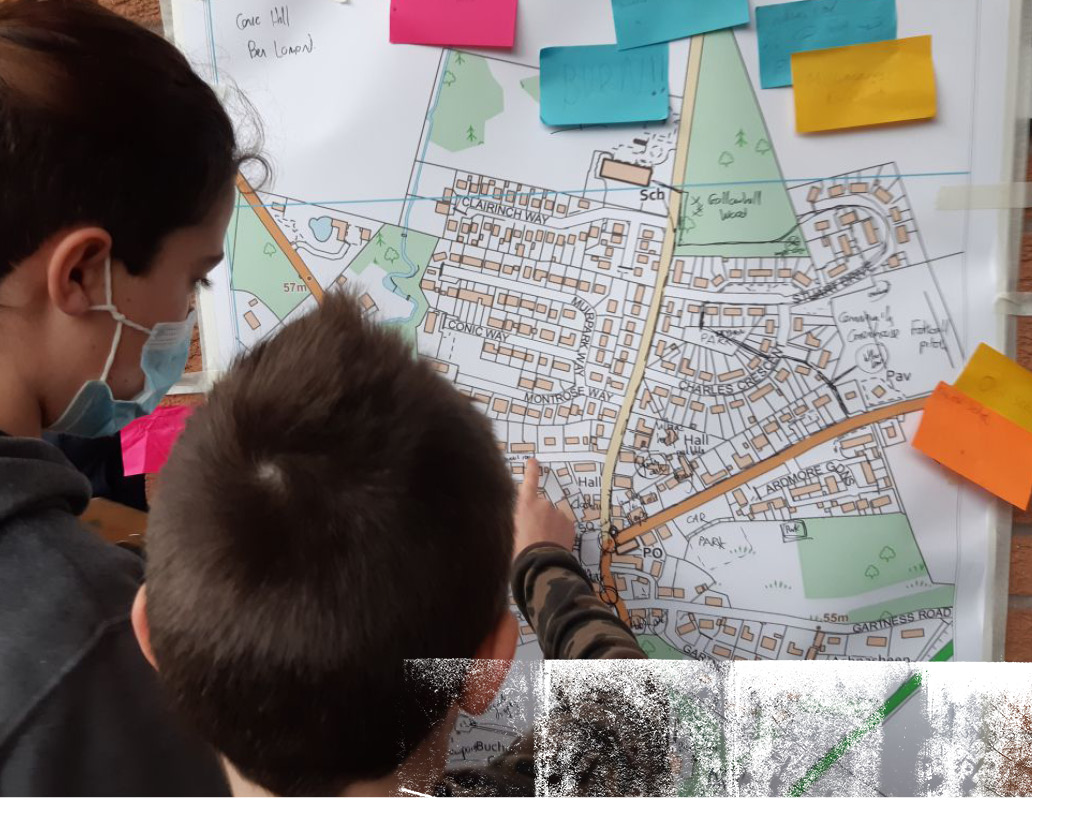
Local Place Plans are also beginning to say more on climate and local living and could be an important tool in supporting this transition. A pilot project in Drymen explored with the community how people can live more locally, linking with surrounding communities. The findings of this are summarised in ‘Drymen and the villages of East Loch Lomond: Living Well Locally Vision and Routemap’ and are being used by the community to inform their new Local Place Plan. Collaborative initiatives to support communities, such as the current roll-out of regional Community Climate Action Hubs by the Scottish Government will provide more resource as well as opportunities for networking and collaboration at a scale larger than individual community level.
Through our next Local Development Plan, we can also make sure that new housing meets the needs of communities and the economy, and that housing is not being lost to holiday lets and second homes. Evidence from recent housing research highlights the need for innovative solutions to develop alternative affordable housing tenures such as mid-market rent, low-cost home ownership and shared ownership, as well as the need to consider how policy intervention, such as Short Term Let Control Areas might help improve housing availability.
Improving rural transport provision and active travel links between communities will support people living and working here to become less reliant on using cars.
Our aim by 2045
National Park communities are leading the way on net zero living and working and have successfully adapted to living with the future impacts of climate change. As passionate ambassadors for local places, communities have utilised knowledge, skills and influence to deepen sense of place and their connection with nature, culture and heritage, providing a nature-rich, resilient landscape for the next generation.
Use our interactive map to tell us where in the National Park you think there are opportunities to facilitate better local living and working.
Harnessing Development and Infrastructure Investment
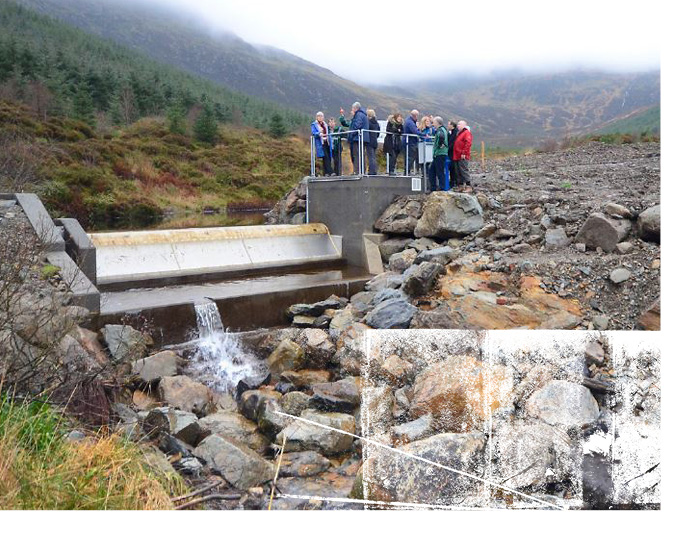
What do we mean by Harnessing Development and Infrastructure Investment?
Significant investment is required within the National Park to deliver outcomes for climate, nature, people and communities. This includes investment in the natural capital held within the National Park’s vast landscapes, investment in our towns and villages to meet development needs of the rural communities and economy – and to support more local living - as well as investing in infrastructure to help ensure the National Park is more resilient to the effects of climate change.
It will be important to secure the right sorts of development and infrastructure investment to realise this and ensure we harness the benefits that development can bring, including for climate and nature.
What is the current situation?
The location of the National Park between the urban central belt of Scotland and the Highlands and West Coast means it hosts nationally strategic infrastructure. The A82, A83, A84 and A85 Trunk Roads, the West Highland rail line, as well as electricity transmission infrastructure, all traverse it and there is a large hydro-electric power station at Sloy, Loch Lomond. This infrastructure requires ongoing maintenance and investment.
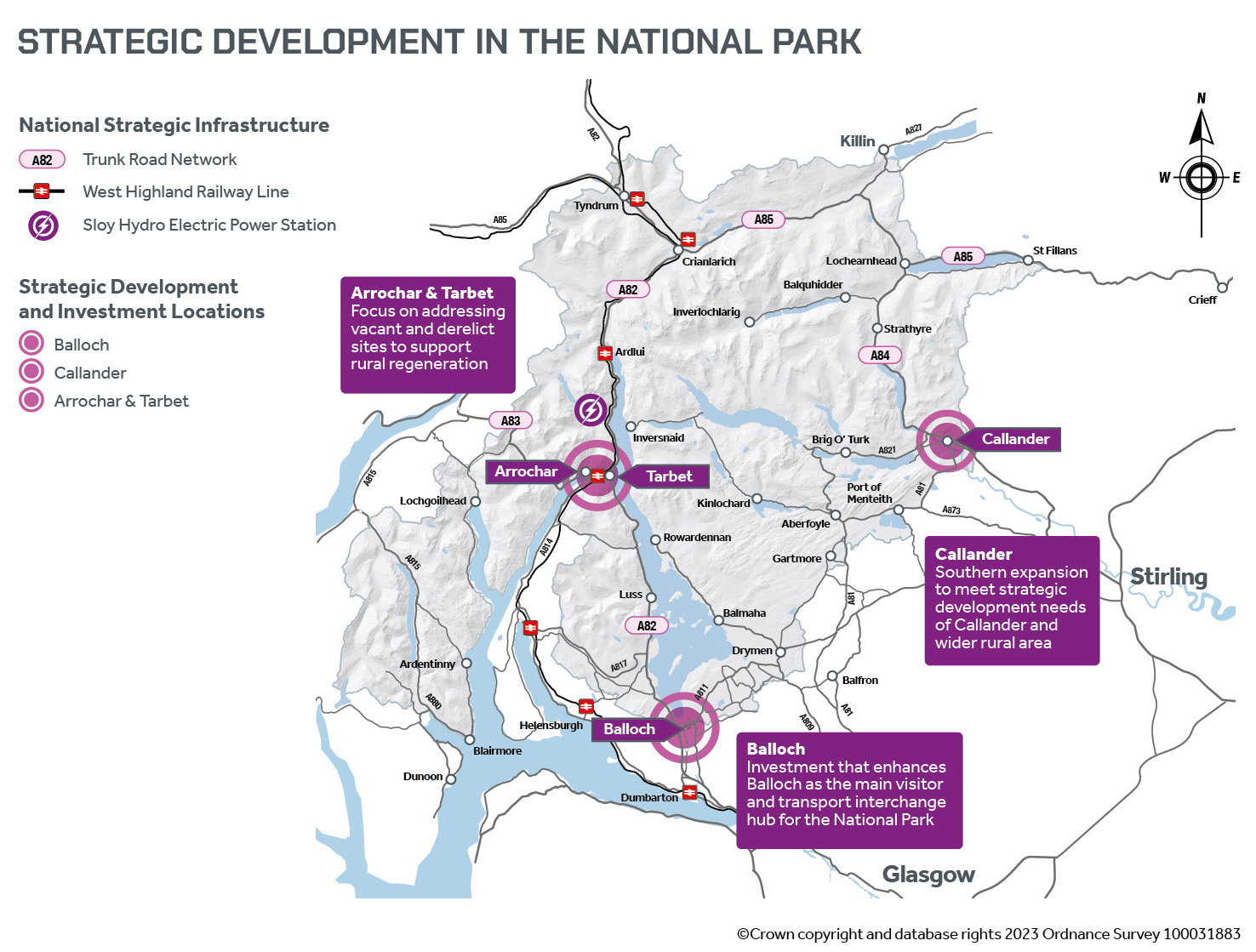
There continues to be considerable demand for inward investment in the National Park, mainly for private housing and tourism-related developments. However, some locations are no longer able to accommodate much more development due to its impact on the environment or insufficient rural infrastructure.

There are also tensions within some communities where there are competing aspirations between local communities and inward investors either over how land is used for development, or over how the benefits from the wealth generated from development is managed. These issues are being highlighted through the preparation of Local Place Plans and when development proposals are submitted.
Significant new development is not expected to be required beyond what was already identified in the current National Park Local Development Plan and is already in the pipeline for delivery. Development that will meet the strategic needs of the National Park and adjoining areas at Balloch and Callander is still considered necessary, as well as a focus on addressing vacant and derelict sites at Arrochar and Tarbet.
There remains a legacy of many undeveloped vacant and derelict sites in and around towns and villages, with some causing significant blight within communities. In villages it is likely that options for increased intervention, such as compulsory purchases, community right-to-buy, and innovative finance options will be required by a range of partners to stimulate and facilitate development on these vacant and derelict sites. The re-use of brownfield sites outside towns and villages will need to be reconsidered in relation to supporting local living, the rural economy and local wealth building and the biodiversity gains that could be achieved by allowing these sites to naturalise.
The delivery of rural development faces challenges. Development costs remain extremely high and across the rural area there is either limited, or a lack of, capacity within existing infrastructure, to support new development in many instances. This is affecting the viability of much needed development in small rural communities and causing delays to delivery of affordable housing at some locations. There is also a need to invest in existing rural infrastructure to repair, improve and strengthen its resilience towards the impacts of climate change.
What could it be?
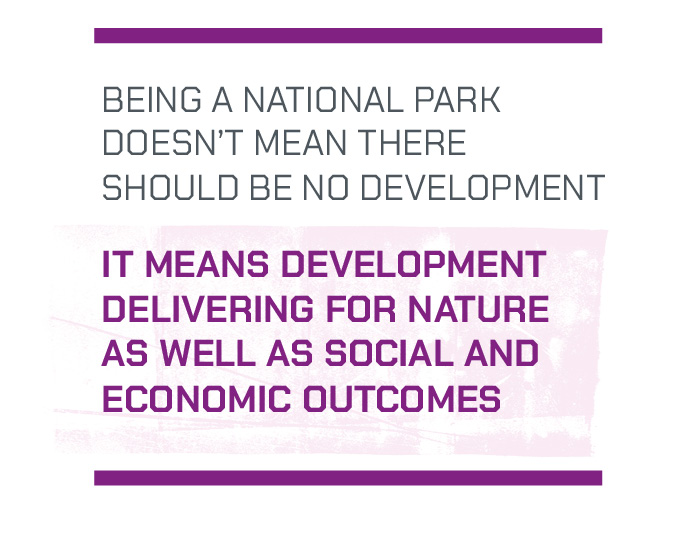
The National Planning Framework for Scotland (NPF4) has introduced new national planning policies and a national strategy for development. It identifies a large part of the National Park, alongside other areas of central and northern Highlands of Scotland, to become an overall net carbon sink, locking in more carbon than it releases into the atmosphere. It also states that new development must help address the climate emergency, restore nature and support the regeneration of the area's communities.
We have an enormous opportunity in the National Park to respond to this in ways that will help deliver local benefits whilst also delivering national outcomes. This means a fresh new approach towards guiding new development and infrastructure in the National Park, that is more closely aligned to facilitating the land use change needed to deliver for climate and nature and meeting the needs of those living and working here.
Through preparing our next Local Development Plan, we can ensure there is an integrated strategy for development and land use. This will ensure nature recovery is secured through identifying opportunity areas for investment in natural capital, strengthening nature networks to support improved ecological connectivity and enhancing biodiversity on site as part of development delivery.
A pilot of this has been trialled in the Strathard area of the National Park. The ‘Strathard Framework’ is an integrated land use and planning framework prepared jointly by the Strathard Community Council, the Strathard Community Development Trust, the National Park Authority and Stirling Council. It identifies the development and infrastructure needs for the area alongside opportunities for investment in natural capital. The focus now is on delivery across all partners. This approach has helped test and consider how similar rural land use and planning frameworks might work in other areas of the National Park.
Investment in land, our natural capital and the range of ecosystem services it provides, will ensure the National Park becomes an overall net carbon sink, and will also help people to adapt to the impacts of climate change, building more resilience for our communities, businesses and the physical infrastructure that supports them.
Our aim by 2045
New development and infrastructure is more responsive to the needs of land use and management, directly contributing to a wellbeing economy that benefits people, climate and nature.
Use our interactive map to tell us where in the National Park you think there are opportunities for investment and infrastructure to help meet this aim.
This engagement phase has finished

...

